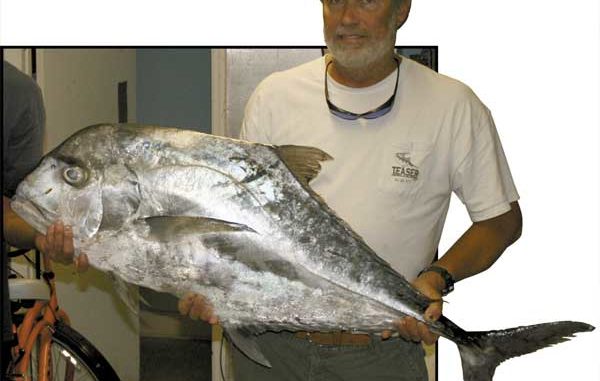
Summer is still the No. 1 time for anglers and their families to get out on the water to do some fishing. Without the competition from spring and fall spectator sports, many tackle shops report brisk summer business and just a lot more talkin’ about fishing. And all that talkin’ leads to more fishing. State-record fish have been caught, licenses for 2008-09 have been sold, and future plans are being discussed.
Shad, Cobia, Flounder
“Diadromous” defines fish that are able to swim from saltwater into freshwater, and American shad can do just that. It is during the spring spawning run when anglers target them for their fight — they are often called a poor man’s tarpon — and their roe. Their run predates man’s presence, and Indians used rocks to make bottlenecks in streams to aid in the earliest of shad harvests.
During a shad’s lifetime, it are preyed upon by striped bass, red drum and even blue marlin as it navigates from a river into the sea and back again. The S.C. Department of Natural Resources has protection of shad stocks on its agenda, holding a public meeting June 30 in Walterboro and releasing the results of its studies. SCDNR plans to stock shad in rivers around South Carolina to maintain the state’s role as a big player in the shad fishery.
Beaufort County residents continue to ask questions about protecting the cobia fishery in the state’s southern waters. CCA made a push for gamefish status for cobia, and while it did not pass the legislature, it did help to raise awareness. At a recent SCDNR Marine Advisory Committee meeting, Col. Alvin Taylor said that 15 game wardens spent hundreds of hours patrolling the area this past spring and did not make a single violation case. A slow season and a high-profile DNR presence helped bring some calm back to this fishery.
The SCDNR did further cobia research, sending out postcards to fishermen in Jasper, Beaufort and Colleton counties to learn about their cobia-fishing activity. Also, several cobia were transferred live to DNR “tankers” and put into the breeding-stock program at the Waddell Maraculture lab; their fast growth makes them a good candidate to be a stocked species. Fishermen donated 98 cobia to the DNR for age and DNA studies.
Disturbing stories concerning the overharvest of flounder while gigging are circulating. Old timers often referred to this as “graining.” Commercial gigging licenses are being used, but questionable practices seem to be the heart of the matter. Sportsmen must always remember that voluntary restraint should be practiced when harvesting fish and game.
Reports of flounder that were tail-gigged — supposedly for a quick measurement — then released as undersized are hard to confirm. But a resulting fist fight on the docks tells me that sportsmen supporting conservation of flounder stocks won’t back down.
Record fish
Its been a busy season for record-setting fish, including sheepshead, white grunt and African pompano. With the mild winters we have experienced and the continued drought, we may be witnessing a change in some local fishing trends. Less harsh winter conditions result in fewer fish kills, and the sizable spotted seatrout being caught this summer indicate many older fish.
Less rainfall means less freshwater coming out of our complex system of rivers and entering our coastal estuaries. Saltwater intrusion from rising ocean levels associated with global warming has already begun changing environments that were once beyond the grasp of lethal salinity rates.
The Savannah River Refuge is losing vast areas of freshwater ecosystems to saltwater intrusion, and ancient cypress trees are beginning to die along the Combahee River due to high saline content.
Coastal waters were warmer than normal at the beginning of this summer, creating a weakened “La Nina effect,” possibly leaving our ocean waters more comfortable for fish. With more fish swimming into South Carolina waters to forage, I think we will continue to see more state-record catches, and I wouldn’t rule out a world- record jack crevalle. There’s never been a better time to chase record fish; pick one species out — perhaps a bonnet-head shark — and you might add “record-breaker” to your saltwater resume.
Federal fishing license
One bit of new business I gathered at the DNR Advisory Meeting regards the federal government putting together a new Federal Registry of Fishing Licenses. Our state government will have a say in the crafting of the federal registry, but there seems to be no way to avoid becoming part of it.
The intention is to catalog all license holders, but this federal license will likely carry its own, additional fee. No federal licenses are expected to be issued until 2011.
State Parks Fishing Opportunities
This year marks the 75th anniversary for the S.C. State Park System, and August is a prime time to visit one of the four coastal state parks that offer pier fishing, surf fishing, and creek fishing.
Myrtle Beach State Park has a full-service, 729-foot pier, and children ages 11 and under can fish for free. Huntington Beach State Park offers creek seining, saltwater impoundments and a pristine beach complete with rock jetty. Edisto Beach State Park offers fishing on the front beach, but also a tidal creek boat ramp for anglers wanting to fish in the waters of the ACE Basin. Hunting Island State Park in Beaufort is an entire barrier island, complete with a 1,120-foot fishing pier, where fishing rods and crab-trap usage is free of charge.



Be the first to comment